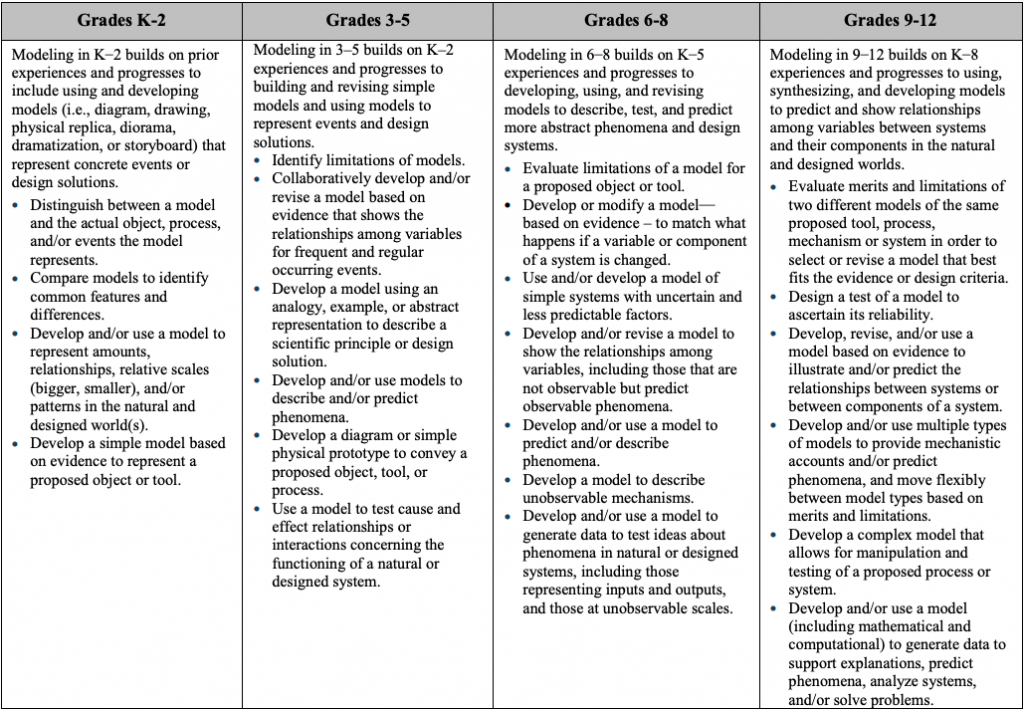How can we be more intentional with lesson planning and effectively remediate students where they need some support. In this post, we’ll walk you through the K-12 progressions and analyze how ideas progress from Kindergarten to 12th grade.
Performance Expectation vs K-12 Progressions
You’re probably most familiar with the NGSS through the Performance Expectations (PEs), which blend the different dimensions of the DCI, SEP, and CCC. These PEs give us the guidelines we expect students to achieve in each grade level band. They’re super helpful for building lessons, but don’t give us much insight into where students are coming from and where they need to go next.
Reading the K-12 Progressions
In this image, we can see two main things:
The K-12 Progressions are the appendices of the NGSS that detail what we want students to be doing from Kindergarten to High School. Let’s see an example for the SEP Developing and Using Models:

First, the grade level bands. Each Performance Expectation is broken into different goals across the four grade level bands (K-2, 3-5, 6-8, and 9-12). The goal is not for students to be able to achieve the goal during 6th grade, but at the end of the 6-8 grade level band.
Second, the elements. Each bullet point within a grade level band breaks down the specific performances for each grade level band. We can trace a student’s development over time by tracking the progress on each element, from one grade level to the next.
Let’s dive into some specific examples of SEPs and DCIs, and CCCs.
Progression of Developing and Using Models
Below, we trace a single element from the SEP Developing and Using Models, from it’s origins in K-2 to it’s most complex version in 9-12. Check out how it evolves over time:
- In K-2, students only need to distinguish between a model and the actual object, process, and/or events the model represents.
- In 3-5, they need to identify the limitations of models.
- In 6-8, they need to evaluate the limitations of a model for a proposed object or tool.
- In 9-12, they’ll need to evaluate the merits and limitations of two different models of the same proposed tool, process, mechanism, or system to select or revise a model that best fits the evidence or design criteria.
This can be used to help students who are struggling with more advanced skills, by giving you prerequisite skills to start with! If a High School student is struggling with comparing two different models types, let's take a step back to the 6-8 grade level band and have them evaluate the limitations of a model. If they also struggle with evaluating limitation of a model, then go back to the 3-5 level, where they identify limitations of a model.
Progression of Structure and Properties of Matter
Below, we trace a single element from the DCI PS1A. Structure and Properties of Matter, from it’s origins in K-2 to it’s most elaborate version in 9-12. What do you notice about out how it evolves over time:
- In K-2, students need to understand that matter exists as different substances with observable properties. Other properties are suited to different purposes. Objects can be built up from smaller parts.
- In 3-5, students acknowledge that because matter exists as particles too small to see, it is always conserved even if it seems to disappear. Measurements of various observable properties can be used to identify particular materials.
- In 6-8, students will know that matter is composed of atoms and molecules that can be used to explain the properties of substances, diversity of materials, states of matter, phase changes, and conservation of matter.
- In 9-12, students will comprehend that the sub-atomic structural model and interactions between electric charges at the atomic scale can be used to explain the structure and interactions of matter, including chemical reactions and nuclear processes. Repeating patterns of the periodic table reflect patterns of outer electrons. A stable molecule has less energy than the same set of atoms separated; one must provide at least this energy to take the molecule apart.
Just like we saw with the SEPs, the DCI progressions can provide helpful direction for helping students refer back to prior knowledge, if they struggle with a specific grade level band, take a step back and try to assess the previous element.
Progression of the Crosscutting Concept Patterns
The elements in the CCC – Patterns progress in a similar fashion from K-2 to 9-12. Below, you can dig into our analysis of one of those elements, to see how it becomes progressively more complex over time.
- In K-2, students need to be able to identify that patterns in the natural and human-designed world can be observed, be used to describe phenomena, and be used as evidence.
- In 3-5, students need to recognize similarities and differences in patterns can be used to sort, classify, communicate and analyze simple rates of change for natural phenomena and designed products.
- In 6-8, students need to acknowledge that macroscopic patterns are related to the nature of microscopic and atomic-level structures.
- In 9-12, students need to observe different patterns at each of the scales at which a system is studied and can provide evidence for causality in explanations of phenomena.
Suppose students are struggling with any of the elements. In that case, we can walk back to another level, even if it means going back to just classifying things by their similarities and their differences.
Extra Practice!
If you’d like to practice and understand the K12 Progressions better, click here to download the Connect the Dots activity. Here you’ll trace ideas from its seedling from K-2, into its expansion and development through 9-12

